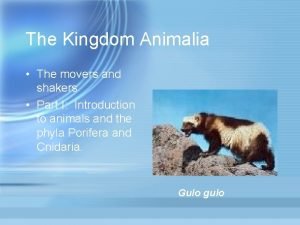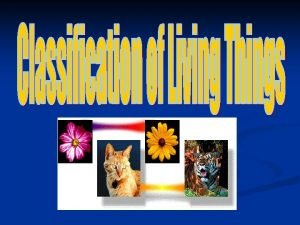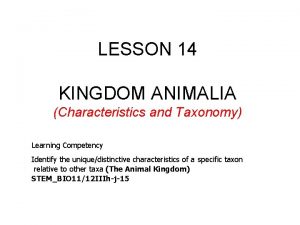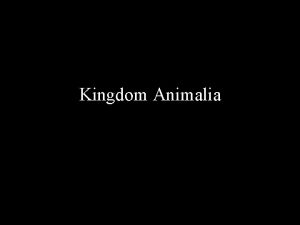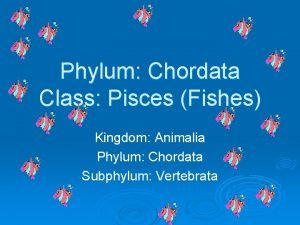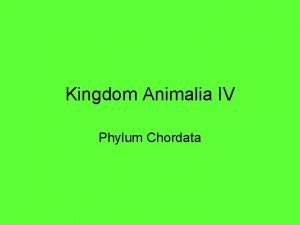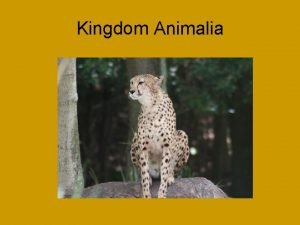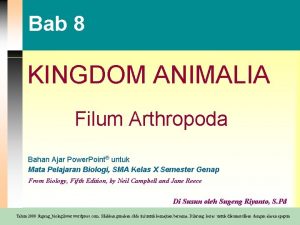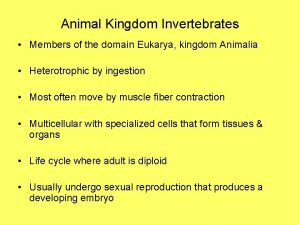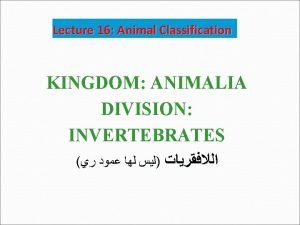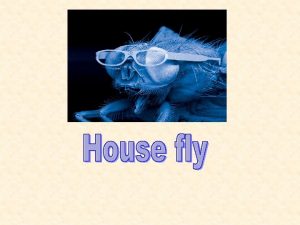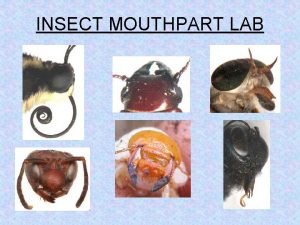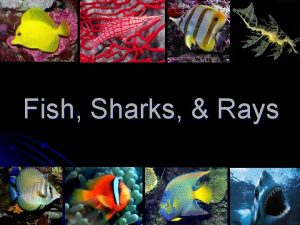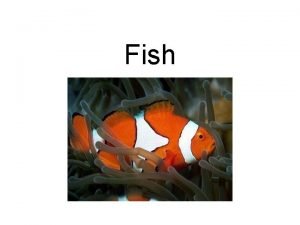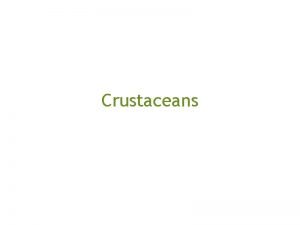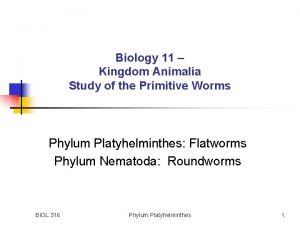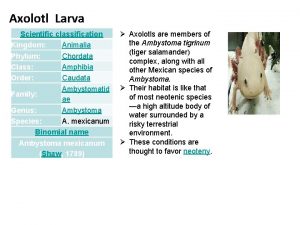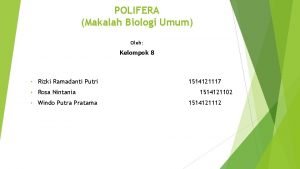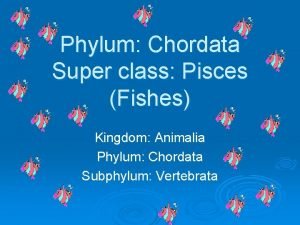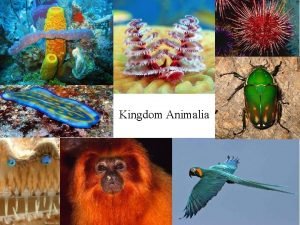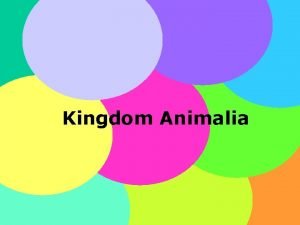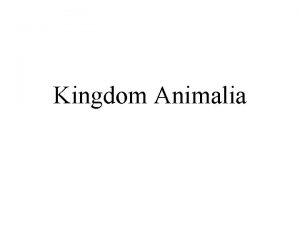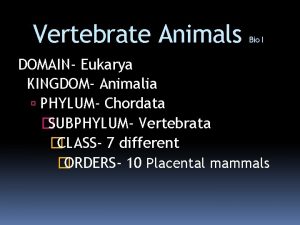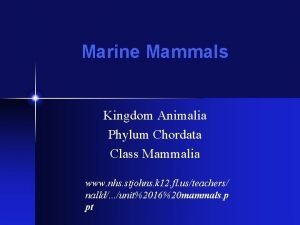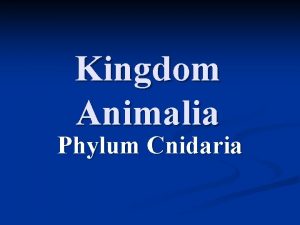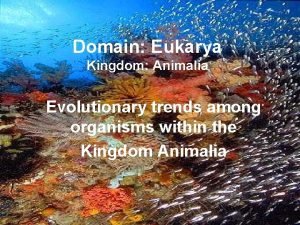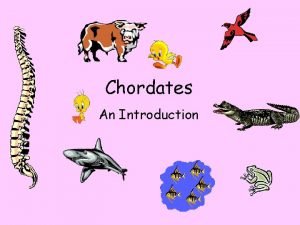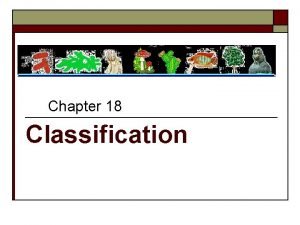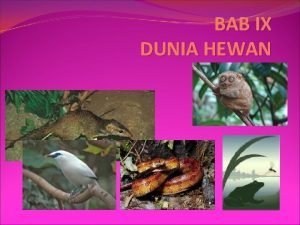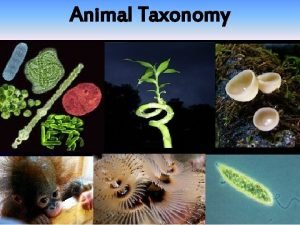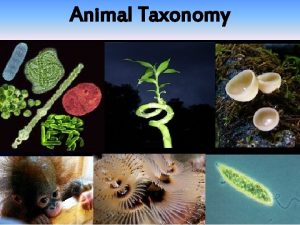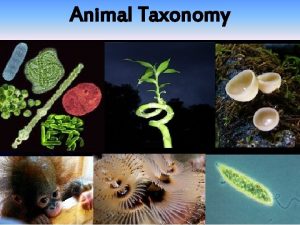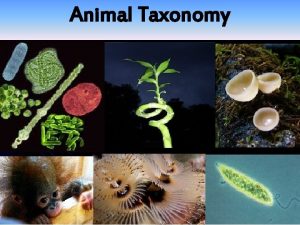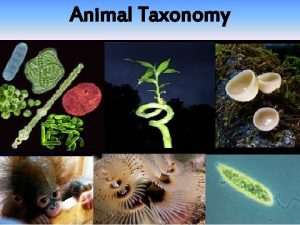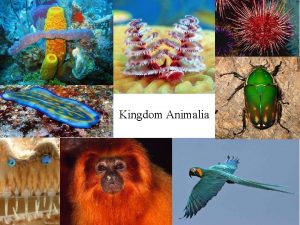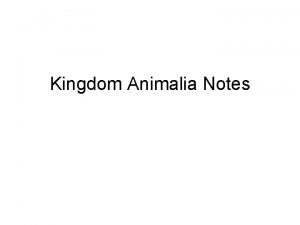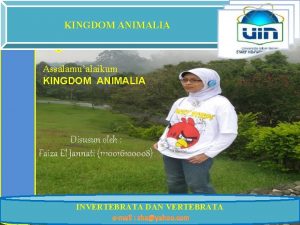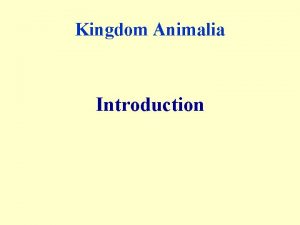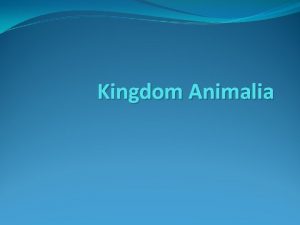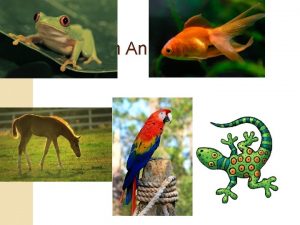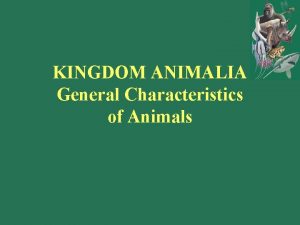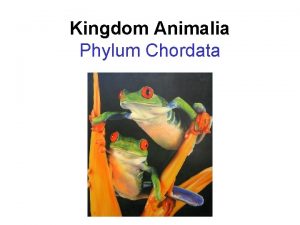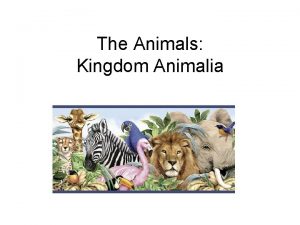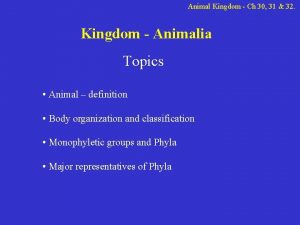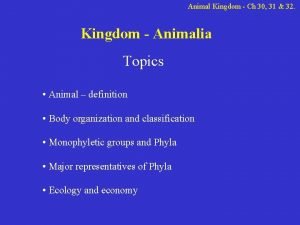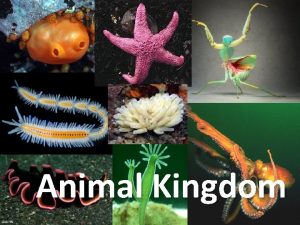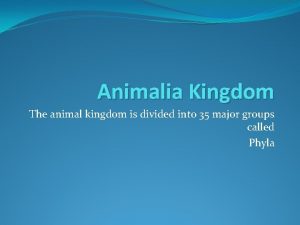Kingdom Animalia What is an animal great variety











































- Slides: 43

Kingdom Animalia

What is an animal? - great variety of sizes, shapes, habitats, etc. - eukaryotes - multicellular - heterotrophs, ingest food - no cell walls, held together by structural proteins (e. g. collagen) - many animals have muscle & nerve cells

Most animals reproduce sexually - diploid stage usually dominates Zygote undergoes cleavage: series of mitotic divisions, without growth - forms a blastula, often like hollow ball

Process of gastrulation leads to formation of germ layers & developmental stage called gastrula

- often a sexually immature larvae, very different from adult morphology & undergoes metamorphosis into juvenile, or sexually mature adult

Animals share a set of genes called Hox genes that control expression of many other genes - determine the pattern of the body during development - set of genes may be duplicated in some animals, perhaps allowing more complex bodies

Animals vary greatly in shape, but often categorized into major body plans (‘bauplan’), set of morphological & developmental traits that work together to produce a successful animal Animal phyla originally based on distinctive body plans (though some aspects may evolve multiple times…) Outdated Phylogeny

Animals may have no symmetry (sponges), or radial symmetry: plane in any direction creates mirror image - have dorsal (top) & ventral (bottom) sides - or bilateral symmetry: only one plane for mirror images - have left/right sides & anterior (front) & posterior (back) as well

Animals with bilateral symmetry typically show cephalization: concentration of sense organs & neural tissue at anterior end

Most animals have tissues: collections of specialized cells, separated by membranes

Tissues develop from germ layers formed during gastrulation Ectoderm – outer surface - forms outer covering of animal, & sometimes central nervous system Endoderm – inner, lines archenteron (space in developing digestive tube) - forms digestive tract, liver & lungs of vertebrates If only these 2 layers, = diploblastic (cnidarians & comb jellies)

Bilateral animals develop 3 germ layers (thus triploblastic), with mesoderm between ectoderm & endoderm - forms muscles & other internal organs Most triploblastic animals develop a body cavity known as a coelom - fluid or air-filled space between digestive cavity & body covering

Coelomates: ‘true’ coelom bounded by mesoderm on inner & outer surfaces - surrounding tissue also suspends internal organs Pseudocoelomates: no mesoderm separating cavity from digestive tract Acoelomates: no body cavity (mesoderm fills space between ectoderm & endoderm)

Coelom serves several functions: - cushions & protects organs - hydrostatic skeleton - allows organs to grow & move independently Coeloms & pseudocoeloms appear to have evolved several times, not associated with monophyletic groups

Animals also categorized by patterns of development as Protostomes or Deuterostomes Protostomes have spiral cleavage (cells not aligned vertically) & each cell has fate determined early Deuterostomes have radial cleavage & cells remain capable of forming any organ until much later

Also differ in how coelom forms: in protostome cavity develops in center of mesoderm mass - in deuterostomes coelom ‘buds off’ from archenteron cavity

Also differ in what forms from blastopore: mouth in protostomes (protos – first; stoma – mouth) - anus in deuterostomes (deuteros – second), mouth forms later at opposite end

Who are the closest relatives of animals? Not so distant from fungi in tree of life, but not closest… Within Unikonta, closest kin are indicated as choanoflagellates

Choanoflagellates morphologically very similar to some cells in sponges (& some other animals…) - DNA sequences & shared proteins indicate relationship - choanoflagellates are filter-feeders in salt & fresh water, solitary or colonial

Animalia (or Metazoa) is agreed to be monophyletic, originating 675 -875 MYA - beyond that, there has been debate, but a clearer picture is emerging The old ‘morphological/ developmental’ phylogeny should probably be disregarded in favor of the changes in the molecular phylogeny

Phylum Porifera – Sponges - earliest branch in phylogeny - recent studies indicate they are monophyletic, though several ancient & distinct groups within the taxon

Sponges are multicellular, but lack true tissues - sessile filter feeders, from a few mm to a few metres - water drawn in through pore into central spongocoel, out through osculum

No tissues, but several cell types - choanocytes line spongocoel, flagellae create currents - outer epidermis with doughnut-shaped cells around pores - inner & outer layers separated by gelatinous mesohyl - amoebocytes move through mesohyl, distribute food & make spicules (silica or calcium carbonate)

- most are sequential hermaphrodites (either produce eggs first or sperm, then switch) - about 5, 500 spp. , mostly marine but 14 spp. in IL

Remaining animals in Eumetozoa, have true tissues First 2 major branches both have radial symmetry & are diploblastic (no mesoderm, but ‘jelly’ between ectoderm & endoderm)

Phylum Ctenophora – Comb jellies Small phylum (100+ spp. ), but can be abundant in ocean - resemble jellyfish somewhat, propelled by 8 ‘combs’ of cilia - capture prey with sticky tentacles

Phylum Cnidaria – Cnidarians (sea anemones, jellyfish, etc. ) Jellyfish Lake, Palau

Diverse phylum (10, 000 spp. ) divided into 4 classes, but share simple radial, diploblastic body plan - 2 forms, typically sessile polyp & mobile medusa - central gastrovascular cavity with single opening (mouth & anus)

Tentacles around mouth for capturing prey, covered with cnidocytes - contain cnidae, ‘explosive’ organelles - many contain nematocysts – stinging thread with venom can penetrate prey & hold it

Have contractile tissues & a nerve net (but no brain) to coordinate movement, sensory structures around body

Class Hydrozoa – hydras, Portuguese man-of-wars, etc. - usually alternate between medusa & polyp stages - freshwater hydras only as polyps - polyps typically asexual, sexual reproduction by medusae

Class Scyphozoa – jellyfish (‘jellies’), sea nettles - only ~200 spp. , all marine - coastal spp. may have polyps, but others lack them

Class Cubozoa – Box jellies, sea wasps - only ~30 spp. all marine, usually tropical - ‘cube’ or ‘box’ shaped medusa, complex eyes on fringe of medusae - may be dangerously toxic

Class Anthozoa – Sea anemones & corals - largest class (~6, 000 spp. ), all marine - only polyp stage

Corals may be solitary or colonial - may secrete calcium carbonate skeleton - coral reefs are extremely productive & diverse marine habitats

Remaining phyla all belong to the Bilateria - bilateral symmetry - three germ layers

Phylum Acoela – Acoelomate flatworms - small group (~400 spp. ), tiny marine animals, formerly included in Platyhelminthes - branched off before 3 main groups of bilateria, may suggest ancestral traits - very simple anatomy: no coelom, no true gut (no epithelial lining), nerves slightly denser at front end

Next section of phylogeny includes mostly animals with ‘protostome’ style of development Divided into 2 main groups, Lophotrochozoa & Ecdysozoa

Lophotrochozoa - 18 phyla with diverse body plans recognized by genetic similarity - some use a lophophore w. ciliated tentacles for feeding - others have a trochophore larval stage - but… others have neither

First phylum in Lophotrochozoa is Platyhelminthes – the Flatworms - ~20, 000 spp. ? - also acoeolomate & triploblastic, but usually more complex than Acoela - gastrovascular cavity does have epithelium, distinct ganglia at anterior end of 2 ventral nerve cords

- thin dorsoventrally flattened body, often w. cilia - no respiratory organs or circulatory system - simple excretory system mostly to maintain osmotic balance

Divided into 4 classes: Class Turbellaria - most free-living (unlike other classes) - most marine (some large & beautiful), a few freshwater (e. g. Dugesia, planarians) - glide w. ventral cilia & mucus, or swim w. undulating muscles - some reproduce by fission, or sexual reproduction by crossfertilizing hermaphrodites

Class Monogenea – monogeneans - external parasites of fish (or hippo) with relatively simple life cycles
 Animalia cell type
Animalia cell type Old kingdom middle kingdom new kingdom
Old kingdom middle kingdom new kingdom Nnn ruled
Nnn ruled Youtube egypt
Youtube egypt Mentohotep
Mentohotep Nine phyla of kingdom animalia
Nine phyla of kingdom animalia Kingdom animalia cell structure
Kingdom animalia cell structure Characteristics of animalia kingdom
Characteristics of animalia kingdom Paramecium cladogram
Paramecium cladogram Animalia cladogram
Animalia cladogram Fish teeth pisces
Fish teeth pisces Monera protista fungi plantae animalia
Monera protista fungi plantae animalia What are chordates
What are chordates Multicellular characteristics
Multicellular characteristics Ciri insecta
Ciri insecta Domain eukarya kingdom animalia
Domain eukarya kingdom animalia Protista prokaryotic
Protista prokaryotic Division of kingdom animalia
Division of kingdom animalia Entertoxemia
Entertoxemia Kingdom: animalia phylum: arthropoda class: insecta
Kingdom: animalia phylum: arthropoda class: insecta Are insects in the animalia kingdom
Are insects in the animalia kingdom Animalia kingdom
Animalia kingdom Caudal fin shark
Caudal fin shark Fish phylum
Fish phylum Kingdom animalia phylum arthropoda
Kingdom animalia phylum arthropoda Kingdom animalia contains 350 000 species of what
Kingdom animalia contains 350 000 species of what Characteristics of platyhelminthes
Characteristics of platyhelminthes Classification of an axolotl
Classification of an axolotl Cladogram animal kingdom
Cladogram animal kingdom Makalah kingdom animalia
Makalah kingdom animalia Phylum cnidaria characteristics
Phylum cnidaria characteristics Kingdom pisces
Kingdom pisces Kingdom animalia organisms
Kingdom animalia organisms Agnata
Agnata Characteristics of animalia kingdom
Characteristics of animalia kingdom Domain eukarya kingdom animalia
Domain eukarya kingdom animalia Kingdom animalia phylum chordata
Kingdom animalia phylum chordata Cnidaria characteristics
Cnidaria characteristics Evolutionary trends in animal kingdom
Evolutionary trends in animal kingdom Animalia kingdom chordates and vertebrates
Animalia kingdom chordates and vertebrates Kingdom animalia cladogram
Kingdom animalia cladogram Fasciola hepatica
Fasciola hepatica Kingdom fungi and kingdom plantae similarities
Kingdom fungi and kingdom plantae similarities Share
Share





